| Sunday, November 30, 2003 |
12:50 - Just a little G5 love
|
(top)  |
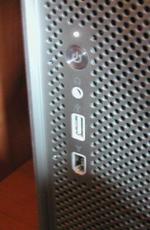
It's overdue, I know-- by several months, in fact. I'd meant to do some G5-related photo-blogging right after I got the thing, but due to one thing and another (and another, and another, and another), it's had to wait.
Indeed, maybe it's all to the good that this comes after my now-infamous meltdown, just to show that no matter what might happen to the data in it, this is still a damn fine machine.
So, let's begin.
The first thing I wanted to show off was the case locking mechanism. The old G3/G4 case, which lasted for some six years in one interation or another, was ingeniously clever-- you pulled a ring on the side panel, and the whole panel hinged down, released from an interlocking metal frame that was moved out of the way by your pulling the ring. You could stick a padlock into a second, smaller ring on the back of the computer-- a protrusion from the inner metal frame that stuck through the back panel-- that prevented the frame from moving and unlocking the hinged side panel that housed the motherboard.
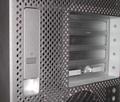   
The new version is quite a bit different, but no less elegant. To open the case, you lift up on this latch, which slides aside three hooks that anchor both the metal outer panel and the inner clear plastic airflow shield. To prevent this, you flip down the little thumb-piece underneath it so its protrusion sticks through the hole, and snap the latch back into place; what formerly was a flush-fitting light gray square is now a padlock hook. Neato.
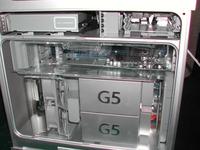
With the latch open, you lift out the side panel (it doesn't have the motherboard on it in this case, which seems more inelegant than the old model only until you see what the "motherboard" looks like) and set it aside. There are instructions for installing RAM and stuff printed upside-down on the inside of the door, so as it hinges down on the tabs at the bottom, you can read them correctly.
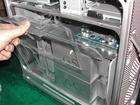
If you've got the G5 sitting on top of your desk (hey, why not? It's quiet!-- Oh yeah, it's got a pretty damn big footprint), you can run it perfectly happily this way-- snap the latch back down and let it run with the airflow shield in place. That way you can sit and stare at the machine's innards all you want, and your co-workers will come by and gawk all day long. Then you can impress them as follows: Explain to them the four heating zones (1, the drives at the top; 2, the PCI-X and AGP 8X slots; 3, the CPUs and cabling; 4, the power supply, hidden out of sight at the bottom), and how they're all fed by the cheese-grater front panel which acts as one big continuous air intake; then point out how quietly everything is running, showing off the low-speed CPU fans which make the whole thing look like one of those musical-guest stages on Saturday Night Live in the early 90s, the sun slanting through a lazily turning fan in the background; then lift the latch, hook your fingers in the divot near the top of the shield, and rotate it out. Listen as the fans all spin up in panic: Aaaaaghhh! I can't guarantee proper conditioned airflow! Mayday! Mayday! Lower the processor speed! Kick up all nine fans to maximum capacity! Damn the noise level-- we've got heat to dissipate! Then clap the shield back into place and listen to the fans recompose themselves, settling back into the blessed silence to which they're accustomed.
Speaking of fans, there's this:
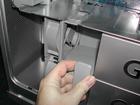 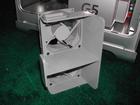
It's the removable, slide-out module containing the two low-speed CPU fans. Warrantied G5 customers might be out of luck if anything related to the insanely complex and welded-into-place case goes awry, but if this fan unit dies, it's absurdly trivial to remove it. Just grab hold of the plastic oval handle and pull it out along its track. It's enough to make a brave man weep.
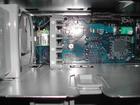
Above the CPU zone is the PCI-X slot zone, which has four slots with little gray numbers. It's like being in the movie Short Circuit. How many times have I cursed at PC cases where I could never be sure which slot was "1" (or, really, "0") according to the hardware, and on top of that, which way the operating system decides to count them? (Linux numbers Ethernet cards in one direction, from furthest-out to closest-in, ending with the motherboard interface if present, while FreeBSD numbers them in the exact opposite direction-- or was it the other way around?) Bah. What a wonderful world it would be, huh?
Up into the next zone, you get this: the drive bays.
 
Granted, the G5 only has space for two hard drives, which is one strike against it in comparison to its predecessors (which all had space for four to six drives, which could be attached to a removable caddy and hooked up by thoughtfully arranged ribbon cables pressed into channels). But the cable management is just as pleasant here. See all those cables lying around, criss-crossing the internal cavity of the machine? Right, I thought you couldn't. There aren't any. Praise be to the Steve, there are no frickin' cables strewn throughout the machine. Instead, there's this one tiny pair of drive cables, stuffed underneath the plastic bay with its latching side rails, with the connectors fitting perfectly into their dormant positions underneath it. Tug them out and you can see just how cool Serial ATA is going to be. There's the big connector and the little connector. Wanna guess which one is power, and which one carries all that high-speed data? Yup: power is on the left. And if I may dare to dream, I've wrestled with my last stupid ribbon cable.
(No, wait. There are still all those PCs in the lab. Damn.)
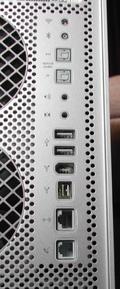
Shifting our gaze to the back side of the machine, here's the stack of connectors. Now this I like. (As opposed to all the previous stuff, which apparently I hated. Anyway.) It's the way the back of a computer was meant to look. No multi-pin "D" connectors. No getting the serial cable confused with the VGA port. Well, okay, these days we may have lost some clarity along with the specialization of certain ports (multiple USB ports can't be much more friendly to novices than round sockets clearly marked for "mouse" or "keyboard" or "ADB", and there's always the possibility for confusion between the two audio jacks when fumbling blindly with an arm stretched around the back), and until we get out of the FireWire 400/800 limbo, there will be this annoying mix of the two port styles labeled with the same logo. But this stack of connectors is just so neat and tidy, I can't help but grin at it.

The front of the case looks like this. Little cluster of plugs at the bottom (fed by the only floating cable in the entire computer), and the CD door at the top. Notice how the drive door hinges such that it slides down vertically inside the case's inner surface, making way for the tray to slide out. A far cry from the flip-out door on the front of the old G4 case, which simply flopped out of the way of the stock DVD-RAM drive's door as it pushed its way out like an alien being born.
And finally, there's this:
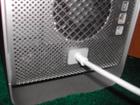
How do I love thee, power supply at the bottom? Oh, the rapture of properly realized design, where the heaviest crap goes on the bottom, the biggest cord plugs in near the floor so it doesn't dangle over all the rest of your (smaller and more delicate) cords and get in your way, and where the plug itself is designed so it fits flush into the square opening so it looks almost like the cord is built into the unit. There's love in this box, ladies and gentlemen.
These photos are, naturally, not exactly what you'd call art-gallery quality, and as such they don't do the machine justice. For that, be sure to look at Bill Noll's photos, which are of a single-processor version. And no less cool.
|
|
 Brian Tiemann
Brian Tiemann















